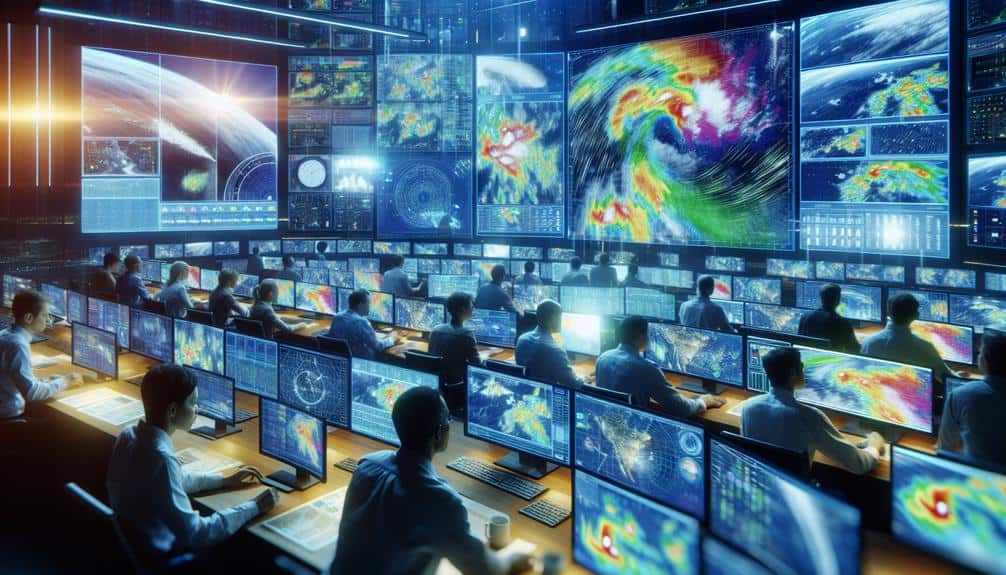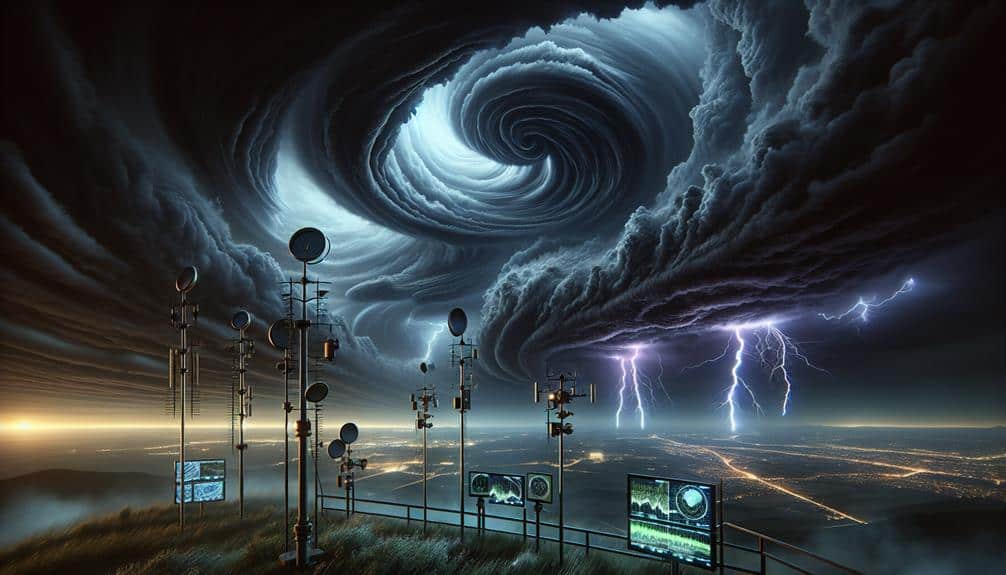We harness satellite technology to revolutionize storm prediction and boost community preparedness. Our geostationary and polar-orbiting satellites provide real-time data on atmospheric conditions, sea surface temperatures, and cloud formations. Using advanced radiometers, spectrometers, and scatterometers, we gather precise information on wind speeds, moisture levels, and temperature gradients. Sophisticated algorithms and machine learning models analyze this raw data to predict storm trajectories and intensities. Additionally, real-time monitoring enhances safety during storm chasing by enabling informed decision-making. By integrating these technologies, we can offer early warnings and detailed storm forecasts, greatly improving readiness. Continue for an in-depth exploration of these methodologies.
Key Points
- Geostationary satellites provide continuous monitoring of specific regions, crucial for real-time storm tracking and forecasting.
- Polar-orbiting satellites offer global coverage, enhancing the accuracy of weather predictions and storm monitoring.
- Advanced instruments like radiometers and scatterometers measure atmospheric parameters, aiding in precise storm prediction.
- Machine learning algorithms analyze satellite data to identify emerging weather patterns and predict storm behavior.
Importance of Satellite Technology
Satellite technology plays an important role in providing us with real-time data and predictive models essential for accurate storm forecasting. By leveraging satellite applications, we can gather vital information on atmospheric conditions, sea surface temperatures, and cloud formations. This data, collected from various layers of the Earth's atmosphere, allows meteorologists to create sophisticated weather forecasting models.
When storms are brewing, satellites give us the freedom to monitor their development and trajectory in near real-time. We can track parameters like wind speed, humidity, and precipitation, which are essential for predicting the intensity and path of storms. This capability is invaluable for early warnings and preparing communities for potential impacts.
Moreover, satellite applications enhance our ability to analyze historical weather patterns and climate data. This extensive dataset helps refine our predictive models, making them more precise over time. We're not just reacting to weather events; we're anticipating them.
Incorporating satellite technology into weather forecasting systems empowers us with the freedom to make informed decisions, minimize risk, and protect lives and property. Through real-time data and predictive analytics, we're better equipped to face nature's challenges head-on, ensuring a safer and more resilient society.
Types of Satellites Used
To understand how we achieve such exact and timely storm predictions, we must examine the different types of satellites employed in weather forecasting.
First, we have geostationary satellites, which remain in a fixed position relative to the Earth's surface. Their primary advantage is continuous monitoring of specific regions, providing real-time satellite imagery essential for storm tracking. These satellites, like NOAA's GOES series, enable us to observe storm formation and movement with unparalleled precision.
Next, polar-orbiting satellites traverse the Earth from pole to pole, covering the entire globe in a series of orbits. They offer a broader perspective, capturing detailed snapshots of the atmosphere at different times. This data augments our weather prediction capabilities by offering extensive global coverage, which is necessary for understanding large-scale weather patterns.
Additionally, we utilize environmental monitoring satellites equipped with advanced sensors that measure various atmospheric parameters, such as temperature, humidity, and wind speeds. These satellites enhance our ability to develop accurate weather models and improve storm prediction accuracy.
Data Collection Methods
By utilizing a variety of advanced instruments and techniques, we gather crucial atmospheric data that serves as the foundation of our storm prediction models.
First, our satellites capture detailed satellite imagery, providing us with up-to-the-minute visual data on evolving weather patterns. This imagery, obtained from both geostationary and polar-orbiting satellites, helps us monitor cloud formations, ocean surface temperatures, and wind speeds.
We also utilize cutting-edge radiometers and spectrometers to measure radiation emitted by the Earth's surface and atmosphere. These tools enhance data accuracy by detecting variations in thermal energy, which are essential for identifying temperature gradients and moisture levels.
Additionally, scatterometers on satellites measure the reflection of microwave signals off the ocean's surface, offering precise data on wind speed and direction over water bodies.
Our forecasting techniques further benefit from GPS radio occultation, where signals from GPS satellites are refracted by the Earth's atmosphere. This method provides detailed vertical profiles of temperature, pressure, and humidity.
Analyzing Satellite Data
Interpreting the extensive array of data collected from our satellites involves sophisticated algorithms and powerful computational models that help us understand and predict storm behavior with remarkable precision. We start by ingesting raw satellite data, which includes various meteorological parameters such as temperature, humidity, and wind speed. This data is then processed through advanced data analysis techniques that filter out noise and enhance signal clarity.
Our computational models use machine learning and artificial intelligence to identify emerging weather patterns. By examining historical data alongside real-time observations, we can detect anomalies that may indicate storm formation. These models continuously update, refining their predictions as new data streams in.
Next, we utilize ensemble forecasting, which runs multiple simulations with slightly different initial conditions. This approach allows us to assess the range of possible storm trajectories and intensities, providing a more thorough prediction. The output includes probabilistic forecasts, giving us insights into the likelihood of various outcomes.
Ultimately, our goal is to empower individuals with the freedom to make informed decisions based on accurate, timely weather information. By leveraging cutting-edge data analysis and predictive modeling, we're not just forecasting storms—we're offering a clearer picture of the future.
Impact on Storm Chasing

Utilizing precise satellite data, we've transformed storm chasing by providing real-time insights and predictive analytics that enhance safety and effectiveness. With real-time tracking, we can monitor storm developments as they occur, allowing us to make informed decisions on the go. This capability significantly improves our safety precautions, enabling us to avoid hazardous areas and anticipate sudden changes in storm behavior.
Our equipment readiness is now more crucial than ever. Satellite data forecasts allow us to guarantee all our tools—drones, weather sensors, and communication devices—are fully operational before we set out on a chase. This preparation minimizes downtime and maximizes data collection opportunities.
Communication strategies have also evolved. We're utilizing satellite data to establish reliable communication networks, ensuring that team members stay connected even in remote areas. This constant link is essential for coordinating movements, sharing real-time updates, and executing safety protocols.
Frequently Asked Questions
How Often Are Satellite Images Updated During a Storm?
Coincidentally, during storms, satellite images are updated every 5-15 minutes. This high data resolution and frequent timing intervals enhance image clarity, boosting forecast accuracy. We rely on this precision to guarantee timely, accurate storm predictions for everyone's safety.
What Are the Main Limitations of Using Satellites for Storm Prediction?
We face forecasting challenges due to data accuracy limitations when using satellites. Atmospheric conditions and technological constraints can lead to less precise predictions, making it harder to guarantee the freedom to prepare effectively for incoming storms.
How Do Satellites Differentiate Between Types of Storms?
We use satellite technology for storm classification by interpreting data on weather patterns. By analyzing temperature, humidity, and wind speed, we can differentiate between types of storms and accurately predict their paths and intensities.
Can Satellite Data Predict the Exact Path of a Storm?
Imagine storm clouds swirling. We can't predict the exact path due to storm variability, but satellite data accuracy enhances forecasting methods. Track prediction improves, yet uncertainties remain, reminding us of the unpredictable freedom nature wields over us.
What Are the Costs Involved in Maintaining Weather Satellites?
When we consider the costs involved in maintaining weather satellites, we must factor in maintenance, data accuracy, and image frequency. Ensuring high data accuracy and frequent imaging can be expensive but is essential for reliable weather predictions.


